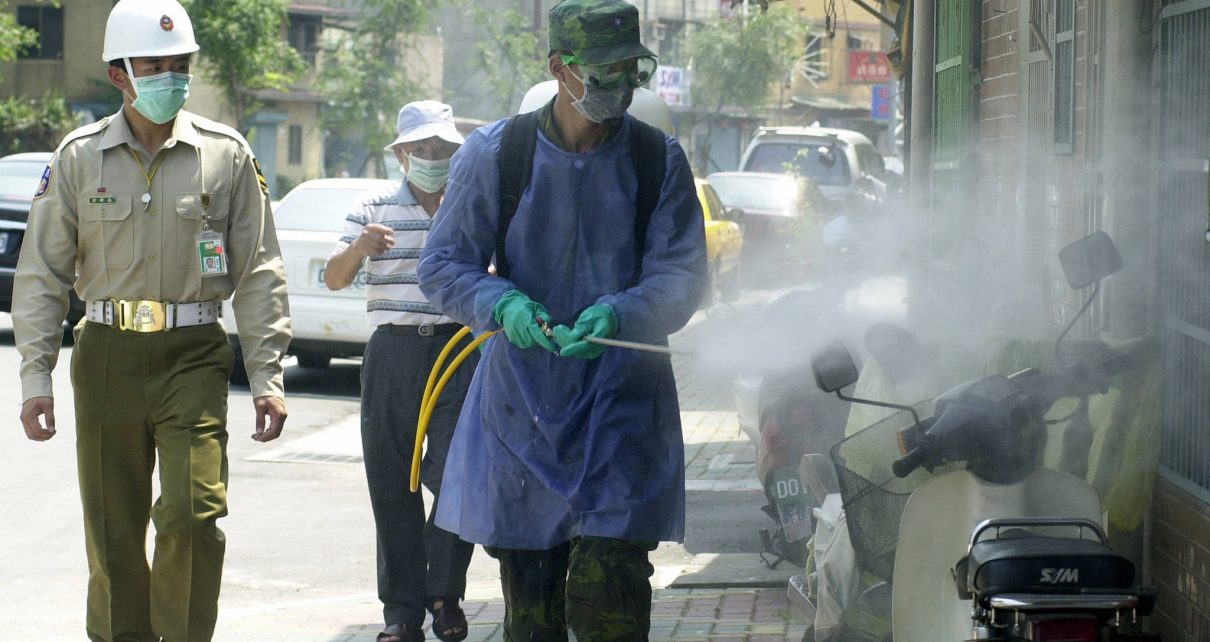Like all pandemics, it started out small. A novel coronavirus emerged in Brazil, jumping from bats to pigs to farmers before making its way to a big city with an international airport. From there, infected travellers carried it to the United States, Portugal and China. Within 18 months, the coronavirus had spread around the world, 65 million people were dead and the global economy was in free fall.
This fictitious scenario, dubbed Event 201, played out in a New York City conference centre before a panel of academics, government officials and business leaders last October. Those in attendance were shaken — which is what Ryan Morhard wanted. A biosecurity specialist at the World Economic Forum in Geneva, Switzerland, Morhard worried that world leaders weren’t taking the threat of a pandemic seriously enough. He wanted to force them to confront the potentially immense human and economic toll of a global outbreak. “We called it Event 201 because we’re seeing up to 200 epidemic events per year, and we knew that, eventually, one would cause a pandemic,” Morhard says.
The timing, and the choice of a coronavirus, proved prescient. Just two months later, China reported a mysterious pneumonia outbreak in the city of Wuhan — the start of the COVID-19 pandemic that has so far killed around 650,000 people.
Morhard was not the only one sounding the alarm. Event 201 was one of dozens of simulations and evaluations over the past two decades that have highlighted the risks of a pandemic and identified gaps in the ability of governments and organizations around the world to respond.
The exercises anticipated several failures that have played out in the management of COVID-19, including leaky travel bans, medical-equipment shortages, massive disorganization, misinformation and a scramble for vaccines. But the scenarios didn’t anticipate some of the problems that have plagued the pandemic response, such as a shortfall of diagnostic tests, and world leaders who reject the advice of public-health specialists.
Most strikingly, biosecurity researchers didn’t predict that the United States would be among the hardest-hit countries. On the contrary, last year, leaders in the field ranked the United States top in the Global Health Security Index, which graded 195 countries in terms of how well prepared they were to fight outbreaks, on the basis of more than 100 factors. President Donald Trump even held up a copy of the report during a White House briefing on 27 February, declaring: “We’re rated number one.” As he spoke, SARS-CoV-2 was already spreading undetected across the country.
Now, as COVID-19 cases in the United States surpass 4 million, with more than 150,000 deaths, the country has proved itself to be one of the most dysfunctional. Morhard and other biosecurity specialists are asking what went wrong — why did dozens of simulations, evaluations and white papers fail to predict or defend against the colossal missteps taken in the world’s wealthiest nation? By contrast, some countries that hadn’t ranked nearly so high in evaluations, such as Vietnam, executed swift, cohesive responses.
The scenarios still hold lessons for how to curb this pandemic, and for how to respond better next time. Deadly pandemics are inevitable, says Tom Frieden, a former director of the US Centers for Disease Control and Prevention (CDC). “What’s not inevitable is that we will continue to be so underprepared.”
More than a game
Pandemic simulations first started gaining popularity in the 2000s. Biosecurity and public-health specialists took their cue from war-game exercises used by the military, in an effort to stress-test health systems, see what could go wrong and scare policymakers into fixing the problems. In these round-table events, academics, business leaders and government officials made real-time decisions to deal with an expanding crisis, laid out in television-news-style reports.
Two early simulations involved biological attacks, in which other countries unleashed smallpox in the United States. Operation Dark Winter, in 2001, and Atlantic Storm, in 2005, were orchestrated by biosecurity think tanks in the United States and attended by influential leaders, such as the former head of the World Health Organization (WHO), Gro Harlem Brundtland, and Madeleine Albright, the secretary of state under former president Bill Clinton (see ‘Games without frontiers’).
During the course of Dark Winter and Atlantic Storm, participants found that power struggles between federal and state leaders bogged down a health response as the epidemic doubled and quadrupled. Hospitals were unable to handle the influx of people requiring care, and national vaccine stockpiles ran dry. Tom Inglesby, director of the Center for Health Security at Johns Hopkins University in Baltimore, Maryland, which helped to lead both of the exercises, says that along with the fresh memory of terrorist and anthrax attacks in 2001, these events encouraged the US Congress to act. Not long after the Dark Winter exercise, the US government committed to developing a national supply of smallpox vaccines. And in 2006, Congress passed the Pandemic and All Hazards Preparedness Act, to improve the nation’s public-health and medical response capabilities in the event of an emergency. This included funding for research on emerging infections.
Anxiety about pandemics was also rising internationally. Not long after the 2003 outbreak of severe acute respiratory syndrome (SARS) spread to more than two dozen countries, and killed 721 people in mainland China, Hong Kong and Taiwan, the 194 member states of the WHO agreed to bolster the world’s defences against health threats through a set of rules called the International Health Regulations. These included commitments by countries to invest in pandemic preparedness, and to report outbreaks to the WHO so that other nations could be alert. The regulations were put to the test in 2009, when an H1N1 influenza virus is estimated to have killed more than 100,000 people, and again in 2013, with the spread of Middle East respiratory syndrome (MERS). Then came the world’s largest outbreak of the Ebola virus, in 2014–16, which killed around 11,000 people — roughly half of those infected.
In response to the drumbeat of epidemics, the United Nations commissioned a panel to explore how the world could better prepare for future threats. The resulting 2016 report made several recommendations, including investment in vaccines, therapeutics and diagnostics for emerging infectious diseases — and a need for “all relevant responders” to take part in infectious-disease simulations.
In January 2017, the World Bank and the Bill & Melinda Gates Foundation in Seattle, Washington, backed a pandemic simulation at the World Economic Forum in Davos, Switzerland — a gathering of global leaders in business, politics and academia. The exercise highlighted a need for better coordination between companies, governments and non-profit organizations when it came to managing global supply chains for medical equipment, diagnostic tests, treatments and vaccines. The scenario coincided with the launch of an Oslo-based foundation to develop and distribute vaccines for emerging infections, called the Coalition for Epidemic Preparedness Innovations (CEPI). It has received funding from the Gates Foundation, the UK biomedical charity Wellcome and countries including Japan and Germany. At the same time, Morhard and his colleagues set about building a network that would coordinate logistics and regulations globally, such as those associated with the use of potential new treatments, if an epidemic caught hold. “We were working on that when this pandemic hit,” Morhard says. “But it’s become clear that all the things we worked on were not commensurate to what we need.”
False security
As these global efforts were under way, Inglesby felt that his own country wasn’t devoting enough attention to preparing for a pandemic. The fact that the United States saw relatively few deaths from MERS and Ebola might have given policymakers a false sense of security, he says.
In May 2018, with leaders in the White House and Congress who had never dealt with a major epidemic, Inglesby and his colleagues at Johns Hopkins University hosted an exercise in Washington DC called Clade X. It featured a respiratory virus that was engineered in a laboratory. One early lesson of this simulation was that travel bans didn’t stop the virus from gaining ground. Infections spread rapidly below the radar because half of the people infected showed few or no symptoms. Medical supplies ran short, and hospitals were overwhelmed. Federal and state leaders issued conflicting messages. More than 20 months passed before a vaccine was available.
Six top-line recommendations emerged from the exercise. These included reducing vaccine production time, and creating a “robust, highly capable national public health system that can manage the challenges of pandemic response”. Some argue, however, that this emphasis was misplaced in subsequent discussions. Jeremy Konyndyk, a senior fellow at the Center for Global Development in Washington DC, says that members of the biosecurity community have often focused on vaccines, rather than on the complex, systemic deficiencies in the public-health system. They often overlooked the “middle game” in outbreak responses.
“We have a strong end game once there is a vaccine, and we have a strong opening game if countries contain an outbreak when case numbers are low,” he says. But insufficient attention is devoted to harnessing and coordinating enough health workers and biomedical resources to efficiently test people, treat them, find their contacts and quarantine them. This is precisely the conundrum that the United States finds itself in right now.
Clade X and other simulations did capture the challenge of the missing middle game. For example, in an exercise conducted by the US Department of Health and Human Services (HHS) last year, dubbed Crimson Contagion, tourists returned from China with a new flu virus that took hold in Chicago, Illinois, and infected 110 million Americans (the exercise assumed the pathogen was more contagious than SARS-CoV-2 is). Disorganization deepened at local, state and federal levels, as leaders scrambled to implement policies and procure equipment.
A report that followed the simulation noted that the HHS — the agency that oversees the CDC and the Food and Drug Administration (FDA) — doesn’t have clear authority to lead a federal response to a pandemic, or access to the funds to roll out such a response. But as with Clade X, the discussion after the simulation focused on straightforward end-game strategies such as vaccine development, rather than the more complicated strengthening of the national public-health system.
Still, at least Clade X and Crimson Contagion highlighted governmental weaknesses. These shortcomings were less apparent in the Global Health Security Index, and in a complementary effort overseen by the WHO, called the Joint External Evaluation. When it came to detecting new pathogens, this ranking commended the United States for its laboratory networks and “an extensive commercial market” for diagnostic tests.
As the coronavirus pandemic gained speed this year, it became clear that the United States needed more than exceptional lab capacity and legions of epidemiologists to contain the spread of the virus.
The reckoning
By late January, Inglesby was anxious. The coronavirus outbreak was escalating at a frightening pace in China and spreading to other countries, including the United States. These were the kinds of foreboding signs that he had plugged into his simulations. But the Trump administration seemed to view the outbreak as China’s problem, says Inglesby. During the third week of January, Trump posted one reassuring tweet about the coronavirus and around 40 regarding his impeachment hearings, his rallies and defeating the Democrats. The only public action that the government took was to screen travellers coming from China for symptoms at a handful of international airports.
Inglesby knew that travel bans and checkpoints don’t sufficiently prevent the spread of contagious pathogens. So, on 26 January, he listed a series of actions needed to prepare the United States for the coronavirus — dubbed nCoV — in a 25-part Twitter thread. “Global and national leaders should be looking ahead to what must be done to prepare for the possibility nCoV can’t be contained,” he wrote. The list included vaccine development, expansion of personal protective equipment for health-care workers, and “very high numbers of reliable diagnostic tests”.
These actions are key to curbing most infectious diseases, but, in an outbreak, they must occur at hyperspeed. Biosecurity experts had woven this lesson into every simulation, because muddling the response in the early months of an epidemic has catastrophic repercussions. J. Stephen Morrison, director of global health policy at the Center for Strategic and International Studies in Washington DC, says: “You can’t fart around for weeks on end and then give a confused, half-baked, not very serious response.”
Infectious-disease researchers were also worried. Fearing undetected transmission in the United States, scientists in the states of Washington, New York and California started vetting tests that detect the genetic sequence of the virus in late January — including a protocol developed by German researchers and disseminated by the WHO. But their efforts to roll tests out for public use hit a wall at the FDA, which wasn’t ready to authorize them. Meanwhile, officials at the CDC insisted that labs exclusively use tests that it had developed.
The CDC started shipping test kits to public-health departments on 6 February. On a Sunday morning, three days later, Kelly Wroblewski, the infectious-disease director at the Association of Public Health Laboratories in Silver Spring, Maryland, woke up to a flood of e-mails saying that the tests didn’t work. “We always knew laboratory testing was complicated, but it’s something that was often overlooked in these simulations,” says Wroblewski; she had participated in Crimson Contagion just months earlier.
While the CDC scrambled to fix the faulty tests, labs lobbied for FDA authorization to use tests that they had been developing. Some finally obtained the green light on 29 February, but without coordination at the federal level, testing remained disorganized and limited. And despite calls from the WHO to implement contact tracing, many city health departments ditched the effort, and the US government did not offer a national plan. Beth Cameron, a biosecurity expert at the Nuclear Threat Initiative in Washington DC, which focuses on national-security issues, says that coordination could have been aided by a White House office responsible for pandemic preparedness. Cameron had led such a group during Barack Obama’s presidency, but Trump dismantled it in 2018.
In March, the CDC stopped giving press briefings and saw its role diminished as the Trump administration reassured the public that the coronavirus wasn’t as bad as public-health experts were saying. An editorial in The Washington Post in July by four former CDC directors, including Frieden, described how the Trump administration had silenced the agency, revised its guidelines and undermined its authority in trying to handle the pandemic. Trump has also questioned the judgement of Anthony Fauci, director of the National Institute of Allergy and Infectious Diseases and a leading scientist on the White House Coronavirus Task Force.
Confusion emerged in most pandemic simulations, but none explored the consequences of a White House sidelining its own public-health agency. Perhaps they should have, suggests a scientist who has worked in the US public-health system for decades and asked to remain anonymous because they did not have permission to speak to the press. “You need gas in the engine and the brakes to work, but if the driver doesn’t want to use the car, you’re not going anywhere,” the scientist says.
By contrast, New Zealand, Taiwan and South Korea showed that it was possible to contain the virus, says Scott Dowell, an infectious-disease specialist at the Gates Foundation who spent 21 years at the CDC and has participated in several simulations. The places that have done well with COVID-19 had “early, decisive action by their government leaders” he says. Cameron agrees: “It’s not that the US doesn’t have the right tools — it’s that we aren’t choosing to use them.”
The end game approaches
Perhaps the biggest limitation of simulation exercises was that they didn’t actually drive policymakers to prioritize and fund improvements to the public-health system. Morrison now questions whether it’s even possible to do that through simulations alone, or whether people must experience an epidemic at first hand.
After more than 70 people in Taiwan died as a result of SARS in 2003, the government mapped out its emergency-response network. “Every year since then, for the past 17 years, they’ve held annual outbreak exercises and practised, practised, practised,” Morrison says. When the first coronavirus cases were reported in mainland China, Taiwan’s well-oiled systems quickly kicked into gear. Despite its proximity to the outbreak, Taiwan has had only seven deaths from COVID-19 so far.
Now, the United States has experienced a tragedy, too. The daily number of new COVID-19 cases broke records throughout much of July, after many states attempted to reopen their economies. Frieden says that one of the most crucial actions now is for health departments to strengthen their response systems by analysing data in real time, so that they can tailor interventions as needed. “The best public-health programme is a programme that uses real-time data to make real-time decisions,” he says. “Real life is our exercise.”
But the end game that received the most attention in the aftermath of many simulations — drugs and vaccines — might indeed be the only way out for countries, such as the United States and Brazil, that have failed to contain the virus. Here, too, the simulations have warned about the disjointed efforts of governments and businesses. Biosecurity experts hope that CEPI and other initiatives to coordinate research and assistance will finally pay off.
Looking forward, many hope that the mistakes in handling the coronavirus will spur a fundamental reset in how US policymakers think about pandemic preparedness. This means restructuring health systems, empowering public-health leaders and ensuring that all components function in unison in the event of a crisis.
Towards the end of the Event 201 exercise in New York City last year, participants watched a mock news report forecasting that financial turmoil would last for years, or even a decade. But societal impacts — including loss of faith in government and the media — could last even longer. The TV reporter signed off with a question: “Are we as a global community now finally ready to do the hard work needed to prepare for the next pandemic?”
The pandemic in that simulation failed to convince policymakers to act. It remains to be seen whether this one will.
This article is reproduced with permission and was first published on August 4, 2020.




